D.Sc. in Information and Interaction Design

Why This Degree is For You
This program encourages an in-depth exploration of information and interaction design for humans.
Program Type
Locations/Format
Cost
Requirements
Quick Links
Create new applications of technology to enhance the way we work, play and live.
This 48-credit Doctor of Science program encourages an in-depth exploration of information and interaction design for humans. Through interdisciplinary courses in topics like cognitive psychology, library science, computer science, user research, and interaction design, doctoral students become leading researchers and designers who can build innovative design solutions on a solid understanding of human behavior.
This program is unique in its careful balance between theory and practice, and in its focus on the challenges of designing for audiences with special needs, such as children, older adults, people with low literacy skills, or people who need assistive technology. Required coursework will include applied qualitative and quantitative research methods, experiment design, applied statistics, HCI theory, and project management. It is also one of the only doctoral degree programs in human-computer interaction that supports part-time study from anywhere in the world, with evening and online courses (in a live, synchronous format).
When you graduate from this program, you will be able to:
- conduct well-designed quantitative and qualitative user research
- communicate research findings to academic and industry audiences
- evaluate the user research methods in studies performed by others
- develop user experiences that meet the needs of a global and diverse audience and that can accommodate change and growth
- develop new conceptual models and hypotheses of interaction design based on both existing interaction design knowledge and user-centered iterative design
- evaluate the social and cultural effects of information systems and their implementations.
Your studies culminate in a dissertation project with a significant impact on the field; you will submit your dissertation project for evaluation by a committee of faculty and experts. You'll have the opportunity to work on high-impact digital technology projects through cutting-edge research with such tools as a Tobii T60 eye tracker in the UBalt User Research Lab and the immersive visualization technologies in the UBalt Gamelab.
Classes are offered during the evenings, and most classes are also available in a synchronous online format.
- Our students: are primarily educators and industry practitioners who possess refined research and
writing skills and a demonstrated interest in user-centered design and user research.
- Our faculty: Once you’re here, you'll study with nationally prominent faculty members who are recognized scholars in interdisciplinary research. Their accomplishments
range from designing online information and services for “at-risk” audiences, to co-designing
with children, to studying online communities, to developing new game genres.
- Our graduates: have moved into faculty appointments at top universities and leadership positions in business and technology. Many of them combine disciplines in innovative positions—researching virtual communities, for example, or developing new visualizations for Web searches. In this program, you'll have the opportunity to test new approaches to user research and experience design, adding theoretical sophistication to productive practice.
WHY UBALT IS FOR YOU
EMPOWERING YOUR FUTURE
When you graduate, you’ll be prepared to work for businesses, nonprofit organizations and government agencies that deal in, represent or interact with artists and the arts—perhaps in addition to managing your own freelance artistic career. You’ll also be well prepared for graduate-level study in business and the arts.
You’ll take courses in:
- arts production and performance
- history, appreciation and analysis of the arts
- government and business as they relate to the arts
- technology’s impact on and importance to the arts.
With UBalt’s location between the Station North Arts and Entertainment District and the Mount Vernon Cultural District, the neighborhood is your laboratory, and this program will allow you opportunities to work with the city’s theaters, museums, galleries, musical venues and arts advocacy groups, shadowing and assisting artists, attending exhibits and performances, and interning with an artist or arts-related organization.
What Our Graduates Do
Common Roles
- Theaters, museums, and galleries
- Music venues
- Advocacy groups









